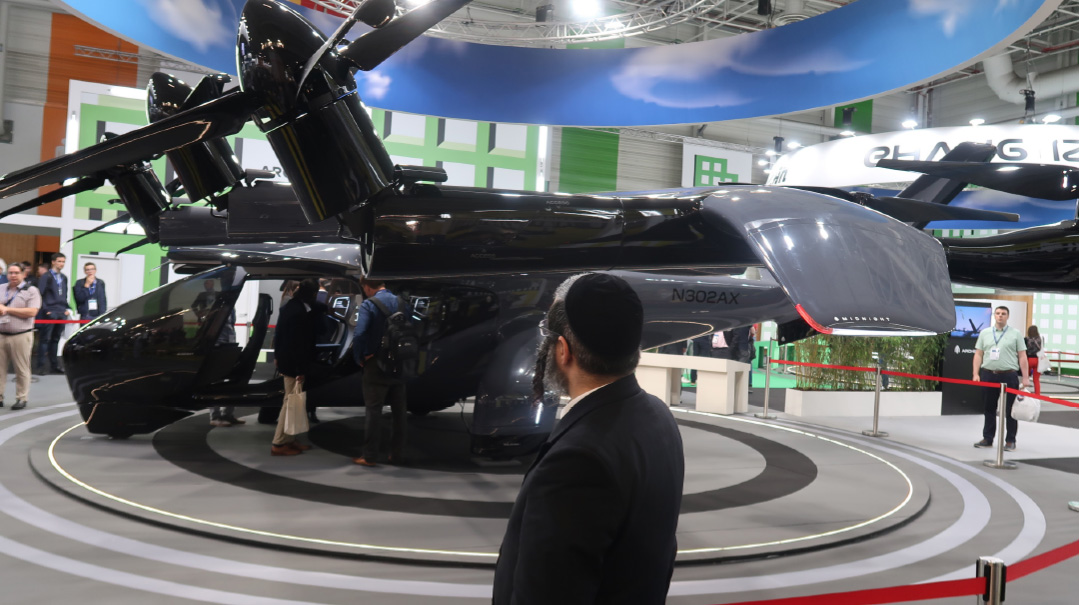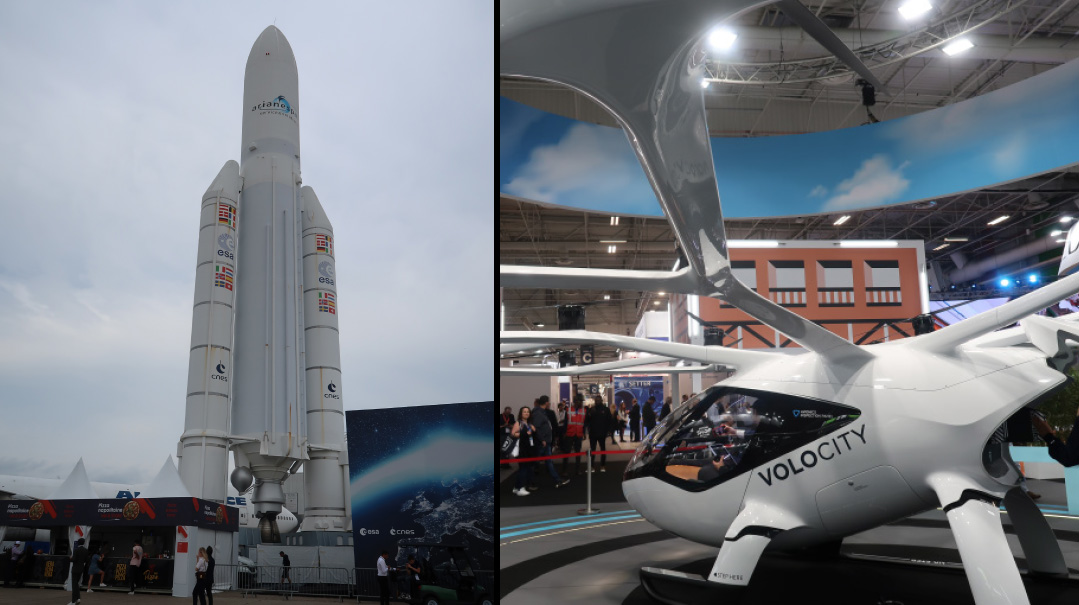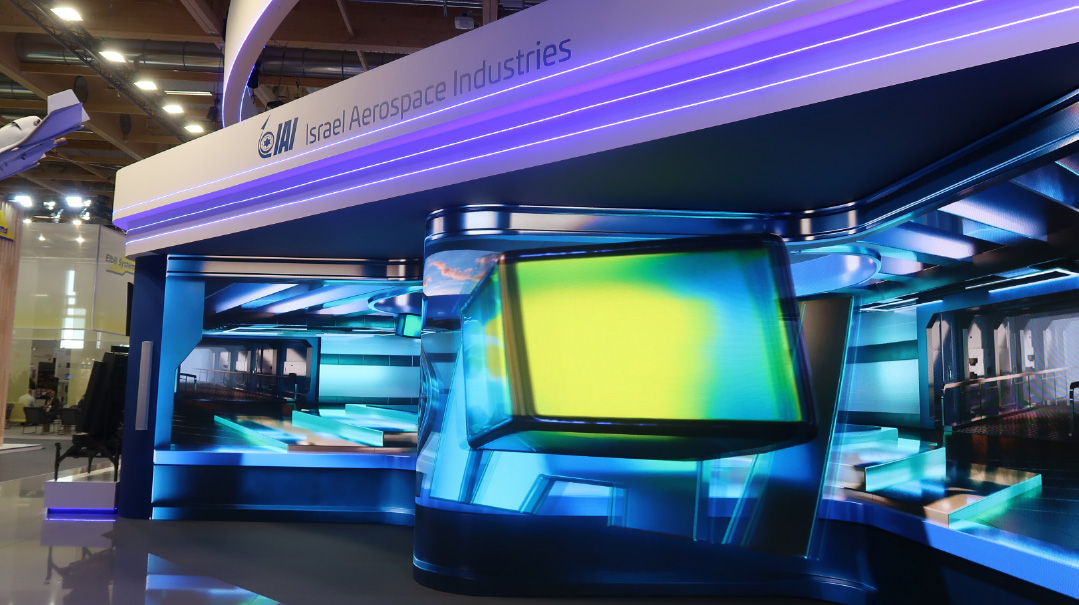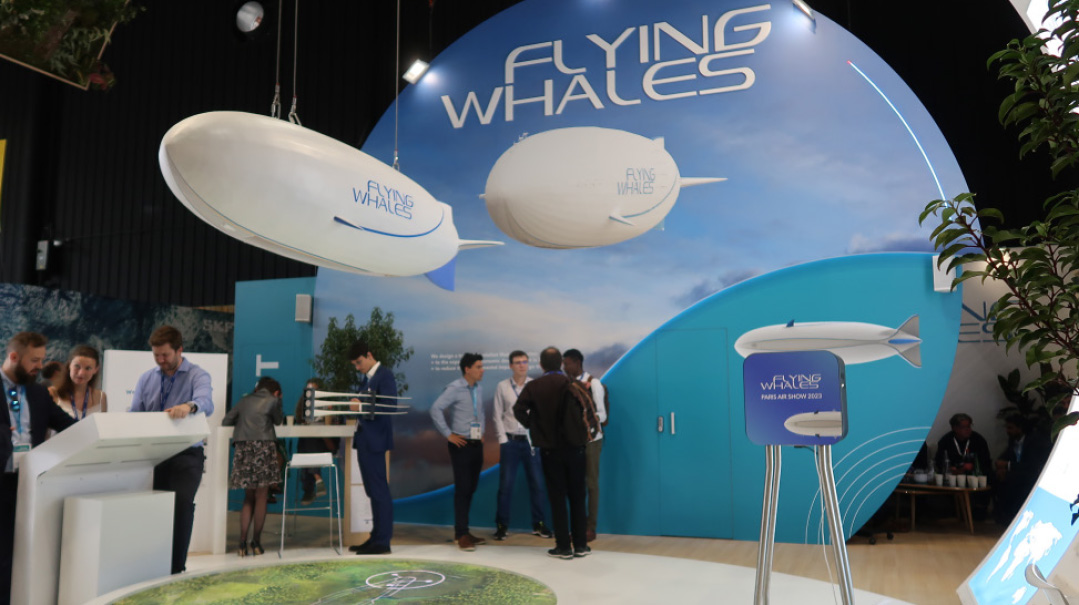Up, Up, and Away

An industry devastated by Covid takes flight again at the Paris Air Show

I
admit, I’m an avowed aviation enthusiast, so attending the international Paris Air Show last month was actually a labor of love.
It’s been four years since the aviation and space industry’s biggest air show was held in person, so the thousands of tourist ticket holders and professionals there to close major aviation deals were especially enthusiastic.
The Covid pandemic devastated air travel, with the aviation industry laying off masses of experienced workers. Thousands of planes were grounded, there was no demand for new ones, satellite companies went bankrupt, affiliated industries took a major hit, and the industry as a whole sank to an all-time nadir.
Now, though, with a surge in air travel demand and airlines desperate for planes to keep up with it, the Paris Air Show — a trade event where companies get a chance to showcase new technology, commercial and military aircraft, and strike deals — was back, a test of the recovering aviation industry. And it turns out that its recovery is stronger than ever.
Airlines are desperate for new planes and crews to staff them in order to meet the exploding demand. People who swore they’d never fly again have found themselves trying to find a flight to some destination and willing to pay the price, while manufacturers Boeing and Airbus are scrambling to fill orders on a long wait list.

Whatever Flies
The Paris Air Show has been taking place for 114 years, beginning just six years after Wilbur and Orville Wright created the first successful flying machine that took to the skies at Kitty Hawk, North Carolina in 1903.
There was probably not too much to see at the time, but from 1953, several years after the jet engine became a standard aircraft feature, the show has been taking place regularly, every two years, in this huge exhibition ground near the La Bourget Airport.
The world’s premier air show is primarily intended for aviation dealers, so the first week is only open to industry professionals and trade visitors before being open to the public. This year, hundreds of thousands of visitors vied for the tourist tickets, which were sold out just a few hours after going on sale.
For those regular visitors who’ve been missing the show these last years, not much has changed. Weapons and aircraft dealers still converge here by the thousands, huddling outside the magnificent booths, finalizing the details of huge contracts while trying to overcome the deafening noise generated by the latest models of aircraft hovering above, displaying the latest in aviation.
And yet, there is one glaring difference. One of the fixtures here had been a Russian Tupolev flying overhead, performing hair-raising stunts. Now, however, there’s not a trace of a single Russian craft. It’s doubtful if, after Russia’s failure on the battlefront, western buyers will ever consider coming back around to Russian manufactured goods. Actually, difficult memories go back 50 years, when a daring exercise by a Tupolev TU-144 Russian plane ended in a horrific crash. The six crew members were killed, along with eight people on the ground who were watching the show.

Green Is the Game
There are five huge exhibition halls — connected by an internal train service — housing thousands of booths, filled with hardworking salespeople endlessly explaining their products to the representatives of companies looking for new developments. Every minute that passes, another contract is signed for the supply of wings, compressors, engines, or perhaps just advanced lighting solutions.
In the middle of one hall, masses of visitors were observing a small aircraft that people initially thought was a helicopter, but which actually turned out to be an electric plane made by the Lilium company in Munich, Germany. It can fly 175 kilometers in a stretch, and according to the company’s energetic spokesman, they already have close to 800 orders. The customers are primarily transport companies and local authorities in search of an effective transportation vehicle that can land on all types of terrain, and that is both environmentally friendly and cheap, in order to serve short-distance needs.
It seems as if “green” is what’s driving the industry today, and it’s not just referring to money. Many new developments factor in environmentally-friendly materials and power sources, and standing here, it feels like there’s a global desire to get rid of polluting fuel and unfriendly composition materials.

More Concealed than Revealed
While the entire route between the exhibition halls is lined with food stands and mobile cafés (there’s no comparing a deal signed with growling hunger pangs to one signed on a full stomach), I suffice with some dry rugelach I’ve brought along.
The Israelis are in Exhibition Hall Three, together with their compatriots from the United States. This hall is crawling with somber-looking Israeli security personnel, although enemy spies have nothing to look for here, as the Israelis make clear to me: The big secrets of the various systems displayed here are well-concealed.
In the Israeli exhibitions, where there’s more concealed than there is revealed, there’s an air of mystery, even as the three large Israeli companies — Israel Aircraft Industries, Rafael and Elbit — exhibit their rich array of products side by side: IAI boasts the Arrow missile designed for exo-atmospheric protection, Rafael is offering a defense system that covers closer threats, and Elbit presents an array of smart defense products that are meant to defend against threats both near and far.
“Even the systems that are sold here, after the approval of the Israeli Defense Ministry (the Ministry coordinates Israeli defense exports, and every deal signed at one of the Israeli booths first needs to be approved by a Defense Ministry representative), don’t include all the features,” says Rami Rosen, the sales rep for Rafael Industries, pointing to an array of security solutions that the company has to offer — from Magic Wand to Iron Dome and David’s Sling, to a more local defense system based on laser beams called Rays of Light, which is expected to be active very soon and will save the defense establishment a lot of money, by reducing the necessity of the more expensive Iron Dome intercept missiles.
Rosen pulls me over to the hottest product the company has to offer: the Skysonic system. It will be the first one in the world to shoot down hypersonic missiles, which have speed capabilities ten times as fast as the speed of sound. The hypersonic threat, especially in the shadow of the Russia/Ukraine war, has made many world leaders lose sleep.
I wonder if the Israeli exhibit has encountered hostility. Rosen just smiles. “The State of Israel is the meteor of the show,” he claims. “People come from all over to inquire about the Israeli technology.”
David Dvash, the representative from the next booth over, nods in agreement. Dvash is a frum Jew from Netanya who works as a systems developer at the Israeli company Enercon, which provides accompanying products to Rafael’s aircraft.
Soon I bump into Yaakov from Rafael, who comes over when he spots my chareidi dress. Standing against the backdrop of Rafael’s defense systems, he tells me in detail about his years in America, about his cancer-stricken father who asked him to return home to Israel, and about a meeting with the Lubavitcher Rebbe, who instructed Yaakov to return to Eretz Yisrael, and promised him a good shidduch and parnassah. “Nothing remained unfulfilled,” Yaakov told me.
Mentioning the Lubavitcher Rebbe, I tried to become a Chabadnik for one day. I took out my tefillin and offered the Israeli representatives an opportunity to perform the mitzvah, but regretfully, it didn’t really succeed. Some were enthusiastic, but explained that it wasn’t appropriate or feasible during work time; others declined at the outset. Next time, I’ll take a few pointers from my Chabad friends to learn their techniques.

The Competition
Jews all over take pride in Israel’s defense capabilities, but looking at the various displays, it’s apparent that a number of European countries produce missile defense systems besides Israel. One such French-made system was presented by a fellow named David, a Torah-observant Jew who works for the French Defense Ministry.
There is no doubt that this prestigious show in Paris provides the French with fertile ground upon which to advance their domestic production, and they take full advantage of it. The French, primarily with the help of the huge companies Dassault and Safran, preside over an impressive flying industry, both civilian and military. And there’s also France’s expansive weapons’ industry, some of whose developments were displayed at the show under heavy French security.
I continued to walk among the booths, peering with 3D glasses at the complex systems and developments, checking a luxury seat in first class produced by a 3D printer, and taking an interest in tiny metal parts that cost thousands of dollars. But my biggest surprise was realizing just how many countries are part of the aviation production industry. I learned that even Romania produces all kinds of interesting aviation solutions.
I was also surprised to find a large and impressive Belgian exhibit, with dozens of companies displaying their innovations. The Belgians, it turns out, are not yet producing actual planes, but they play a significant role in producing parts. Suddenly, after decades of living in the country, I discovered that a large percentage of aircraft wings are produced in the chocolate kingdom, and that’s aside from a factory on the outskirts of Liege that manufactures combat helicopters.
In France’s gargantuan exhibit, I was drawn to a very elegantly designed booth of Flying Whales airships (otherwise known as blimps). Their most talked about airship will be twice the size of Airbus’ largest jet, and it will rise to an altitude of 3,000 meters. The goals of Flying Whales are to expand the economic development in landlocked areas, and to reduce the environmental impact of cargo transport. Its aviation technique is based on those of flying helium balloons, and these ships are emerging to be the next thing in the advanced transport industry.
I was also surprised by the Turkish exhibit. The Turks boast a range of missiles, UAVs and drones, and one representative who told me that over 200 Turkish companies are exhibiting, said that these lethal products are already casting fear and dread on the Ukrainian battlefield.

Backlogged
Hovering over our heads, so to speak, is the presence of the two aviation giants, the American Boeing and the European Airbus companies, but with so many backorders and demand for new planes, as airlines are replacing older aircraft in preparation for future growth in air travel, companies estimate order to delivery can take up to ten years.
Over the past year, Boeing has logged large orders or preliminary agreements from customers including United Airlines, Saudia, and the new Saudi carrier Riyadh Air. India’s massive order earlier this year included both Boeing and Airbus jets. Delta Airlines, Malaysia Airlines, and Air France-KLM are also looking to expand their fleet.
The major challenge for manufacturers now is increasing production. Slots for narrow-body jets, such as Boeing 737s and Airbus A320s, are sold out for years. Now that long-haul travel is returning, some airlines could also be looking to expand their fleets of larger, long-range jets. The production delays have also driven up leasing rates for both new and older planes as airlines search for other opportunities to boost flights.
And some planes are being sidelined for another job altogether, in a small but lucrative corner of the aerospace industry: converting passenger planes into aircraft that can haul cargo. A record 164 planes were converted to air freighters last year alone, as port congestion and strikes wreaked havoc with shipping cargo. Although the process can take months and cost millions of dollars, companies that specialize in this business say they’re still racking up orders to turn planes into freighters.

In the Pilot’s Seat
Dozens of aircraft are parked in the huge expanse around the exhibition structures, including the Brazilian Embraer. This company, which produces small to medium-sized aircraft, endeared itself to me, not only because it’s the poor “underdog” in the aviation world, but also because the extremely courteous Brazilian representative let me sit in the cockpit. It was towards the end of the day and my legs were barely carrying me, so I was especially grateful. But the very next day, I read about an Embraer plane in Brazil whose door opened during takeoff — and my goodwill fizzled out.
Not far away I spotted the 46A-KC refueling plane — the most advanced model in the world, produced by Boeing. According to foreign reports, this is the refueling plane that Israel needs to potentially attack Iran. The Israelis ordered it long ago, but they’re not expected to receive it before 2025. There were Israeli efforts to move ahead in the line, but the Biden administration torpedoed those efforts. There’s a long line of visitors snaking down in the hope of visiting the craft, but once they get there, they find a plane that is empty inside, its walls covered with canvas sheets. The secrets of this craft, it seems, are not on display for us simple folks.
This is the last day of the trade show before the public is allowed in. Tomorrow, the tourists will come, but meanwhile, thousands of sales representatives, company owners, and weapons and aviation dealers are packing up their bags, trying to wind down one of the most fascinating and challenging air shows ever.
Yet in the face of this unbelievable technological advancement, and the unfathomable achievements of humankind, I feel a need to reiterate to myself over and over that it is all from Above. Hashem has always protected us, and will continue to do so for eternity. Arrow missiles and Patriots, or whichever other defense system it may be, are not worth anything without the Divine Spirit that hovers over this entire industry. And as I, too, head for the exit, I hum to myself over and over: Ein od milvado!
(Originally featured in Mishpacha, Issue 972)
Oops! We could not locate your form.







